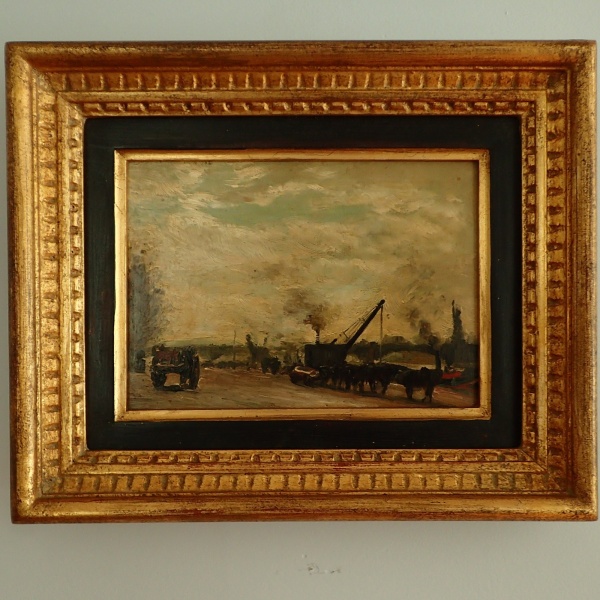The Docks at Grenelle Bridge with the Statue Of Liberty by Benezit

View of The Docks at The Grenelle Bridge with the Statue Of Liberty by Emmanuel-Charles Bénézit
An interesting painting giving a glimpse of what the working docks at the Pont de Grenelle in Paris looked like in the early 20th century.
Full of details this oil painting is warm and inviting even though the subject remains one of labor.
The Painting was dedicated on the rear of the frame by Bénézit to his friend Poincet.
Emmanuel-Charles Bénézit, was born in Paris on November 28, 1887 and died in Hyères on October 17th 1975.
He was a French painter, draftsman, engraver as well as an art historian. He was also the son of Emmanuel Bénézit, owner of art galleries in Paris and none less than the creator of the Dictionnaire Bénézit.
His grandfather, Charles Bénézit, a musician, was a close friend of Victor Hugo, whom he accompanied in exile to Jersey.
Emmanuel-Charles was born into a well-to-do and cultured family. He spent his childhood in his father’s gallery, where artists such as Victor Hugo and Vincent Van Gogh passed through, and developed strong ties with Camille Pissarro and Alfred Sisley, who made frequent visits to his childhood home.
Emmanuel-Charles Bénézit started painting at the age of six. His technique varied a lot throughout his career, but he kept certain constants such as the richness of bucolic landscapes, with complex skies and a harmonious relationship between man and nature.
He assiduously frequented the Louvre museum and was impressed by the great masters, especially Nicolas Poussin and the Venetians.
Free from material constraints, he could devote himself to his art.
Benezit took part in the First World War, but was discharged in 1915 because of a serious lung infection whereupon he left Paris for Provence. There he discovered the light of the Midi and the mistral wind, which seemed to bring distant landscapes to the forefront; he then began to study nature through the light.
He obtained a certain success in the Parisian Salons, exhibiting at the Salon des indépendants (from 1907 to 1928), the Salon d’automne (from 1922 to 1933) and the Salon des Tuileries (from 1926 to 1938). An important exhibition at the Galerie Gérard in 1938 earned him an excellent review by Louis Vauxcelles.
His work (oils, watercolors, drawings) has two aspects: he works on the motif, but also draws his inspiration from his imagination.
Hence a great richness and an astonishing variety of subjects in his work, original and powerful, which finds its unity in the style.
His style is the mastery of drawing, which allows him to reach the intense expression of the character of things. For each painting, for each type of emotion which embraces him, “he chooses in his arsenal the means best adapted to its translation in plastic terms “.
To the mastery of the drawing it is necessary to add that of the color, which can be intense or soft and subtle; it is necessary to note the exactitude of unforeseen and audacious agreements, the juxtaposition of the values, the delicate rubbing or the sumptuousness of the paste. “His drawings, his figurative or abstract painting, are the manifestation of an artist with a multifaceted and fascinating production”.
In the South he lived modestly, giving everything to his work.
He was also actively involved in the re-editing of the Benezit dictionary. He drew and painted until his death at the age of 88.
The Frame measures 101/2 inches x 13 inches
The Painting measures 6 inches x 8 ¼ inches
France 19th Century c.Reference number: R-313
Click here to print.
go back
